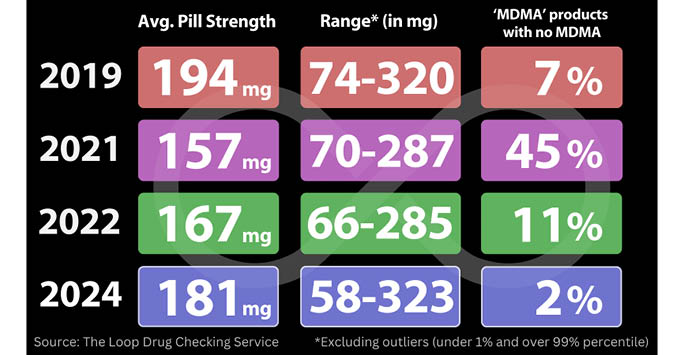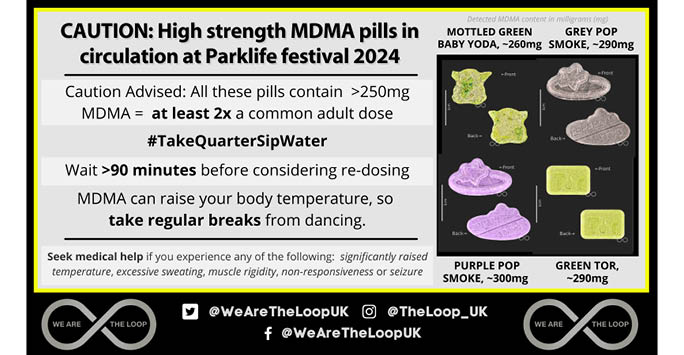'SIZE MATTERS': High strength ecstasy pills are back, so harm reduction communications need to adapt
Posted on: 25 June 2024 by Professor Fiona Measham in Blog

The Loop’s dedicated multidisciplinary team of chemists, health professionals, researchers and media officers returns to the fields this summer, delivering harm reduction services onsite at UK music festivals and issuing alerts and community information posts where useful, to enhance the safety of revellers up and down the country.
Summary
• Average pill strength has increased in 2024, back to pre-pandemic levels (>180mg MDMA);
• The proportion of stronger pills has increased to pre-pandemic levels (>1 in 10 are 250mg+);
• Total pill weight can be a simple indicator of high strength pills and flag up the need for extra caution;
• Timely and context-specific harm reduction communications are extremely important this summer, especially given wider concerns about drug market adulteration.
In January 2024, The Loop launched the first UK Home Office-licensed, fully funded, publicly accessible ‘drug checking’ service (sometimes called ‘front of house’), in Bristol city centre. This is a monthly service which enables The Loop to build a picture of drug market trends and to identify substances of particular concern in circulation.
In June 2024, The Loop launched the first UK Home Office-licensed, non-publicly accessible onsite drug testing service (sometimes called ‘back of house’), at Manchester’s Parklife festival. This further informed The Loop’s drug market surveillance. Across this summer The Loop will continue to test hundreds more samples obtained from onsite support services, ground finds and particularly festival medical emergencies. What we are already noticing is just how much the market has changed this year, compared with the disruptions of the pandemic and post-pandemic periods.
In the 2021 post-lockdown festival season, The Loop found a huge increase in synthetic cathinones and caffeine being missold as MDMA, with nearly half of products sold as MDMA containing no MDMA at all (see Table). There was also a notable fall in pill strength in the post-pandemic period, a trend identified by drug checking services across Europe. By the following summer, however, The Loop noted a substantial fall in synthetic cathinones being missold as MDMA, although ecstasy pill strength had increased only marginally.

The Loop MDMA trends 2019-24.
So far this year, between city centre and festival testing, The Loop has tested over 150 products bought as MDMA, allowing us to build a picture of the market as we go into the summer festival season. The key finding of note is the increase in the average strength of ecstasy pills. High strength MDMA is regarded as one of the biggest contributors to MDMA-related deaths, with The Loop already having tested a number of pills found to contain 300mg or more of MDMA (around three times a common adult dose) and one in ten pills are over 250mg in strength. Significantly, this is the first time that The Loop has tested any pills containing over 300mg of MDMA since before the pandemic.

The Loop social media information post, June 2024.
There could be a significant risk to public health, if people have become familiar with lower strength pills in the last four years or so and are caught unawares by pills containing two or even three times a common adult dose. This risk is heightened for young people, many of whom will have come of age and only started going out and taking ecstasy pills during this post-pandemic period of lower strength pills. This cohort is also the age demographic most likely to experience serious harm as a result of taking ecstasy, unfortunately, with MDMA implicated in 15 of the 18 confirmed festival-related, drug-related deaths in 2017–2023, with a mean age of 23 years old. In 2018, a time when there was a comparable percentage of high strength pills in circulation, 30% of MDMA-related deaths were amongst young people aged under 21.
Festivals themselves are environments which can pose particular risks in relation to drug taking. In the UK, where large scale multi-day events are common, the annual English Festival Survey estimates that over half of festival attendees take illicit drugs at festivals. Moreover, half of these festival drug users take larger quantities of drugs then they usually take outside of the festival environment, a quarter take a wider range of drugs than usual, and these drug taking sessions are stretched across multiple days, often from morning ‘til night. This culture of ‘atypical intoxication’ - combined with binge drinking, sleep deprivation, poor nutritional intake, environmental stimuli and particularly dehydration - can increase the risks associated with high strength pills, especially for a less experienced cohort than would have been the case for young adult festival attendees even five years ago.
A finding which has yet to be widely publicised, but which is intriguing European drug checking services is that there is a statistically significant correlation between the size of an ecstasy pill and the amount of MDMA that it contains. A consistent finding across ten European drug checking services, testing nearly 32,000 ecstasy pills in 2012-21, was that if a pill contained MDMA, then the ratio of MDMA to filler was usually found to be consistent. This ratio seems to be similar regardless of the size of the pill. Thus, while by no means as reliable a harm reduction tool as utilising a drug checking service, weighing an ecstasy pill is a quickfire way to assess the likelihood of it containing multiple doses and therefore being higher risk. If someone discovers an ecstasy pill weights 500mg or more in gross weight, they are advised to proceed with extreme caution, because it might well contain over 200mg of MDMA (twice a common adult dose).
The Loop will be communicating ‘Size Matters’ to people who use ecstasy this summer, to highlight the risks of high strength pills and as a conversation starter to encourage risk reduction behaviours such as #TakeQuarterSipWater. Another simple indicator of higher risk pills is to conduct reagent testing at home. A test result which indicates that a pill does not contain MDMA again suggests proceeding with extreme caution. Furthermore, even if a test indicates that the pill does contain MDMA, reagent tests give no indicator of the strength of a pill, nor the presence of potent adulterants in very low concentrations.
There are other reasons for people to proceed with caution this summer. The UK drug market currently is experiencing a period of turbulence in a number of ways aside from high strength pills. There is the worrying growth in high strength synthetic opioids called nitazenes being used as adulterants in opiate and benzodiazepine markets, resulting in clusters of overdoses and deaths in recent months. Xylazine, a powerful non-opioid sedative normally used in veterinary medicine, is also becoming a more prevalent adulterant around the world. Whilst these drugs are predominantly affecting the opiate and benzodiazepine markets, they have been found in ‘club drugs’ including ketamine in the UK. In Australia, a batch of ecstasy tablets causing hospital admissions from a festival was found to contain nitazenes.
High strength ecstasy pills are again in circulation, with the market returning to pre-pandemic levels, so risk reduction messages - such as take just a quarter at a time, sip water, pace yourself and avoid polydrug use - are as important as ever. The Loop harm reduction team, made up of doctors, nurses, psychiatrists, pharmacists, substance misuse workers, social workers and more, can engage with young people about risk reduction strategies throughout the day, meeting festival attendees, literally, where they are at. This makes festivals a great place to talk about harm reduction with a cohort of drug users who typically haven’t spoken with a health professional before. Prevention is cheaper, more effective and far preferable to the alternative, intervention after an overdose.
Acknowledgements
Thank you to The Loop paid and unpaid staff who make the magic happen and to Jon Drape and everyone at Parklife for supporting The Loop since the start.
Blog for Drug Science and University of Liverpool. Authors: Professor Fiona Measham, founder and Chair of the Loop Drug Checking Service, and Adam Waugh, The Loop Drug Checking Service training lead.
References
For more details on Loop publications please see www.wearetheloop.org/publications
Additional information
EROWID: Oral MDMA Dosages
Threshold : 30 mg
Light: 40 - 75 mg
Common (small or sensitive people): 60 - 90 mg
Common (most people): 75 - 125 mg
Common (large or less sensitive people):110 - 150 mg
Strong: 150 - 200 mg
Heavy: 200 + mg
Onset : 20 - 70 minutes (depending on form and stomach contents)
Duration : 3 - 5 hours
Normal After Effects : up to 24 hours
Keywords: research, drug checking, harm reduction, nightlife, festivals.